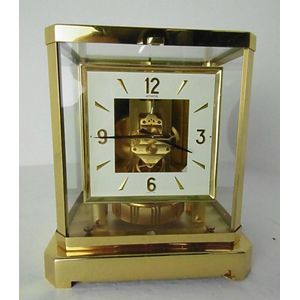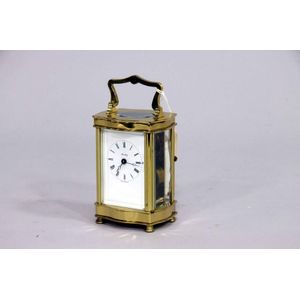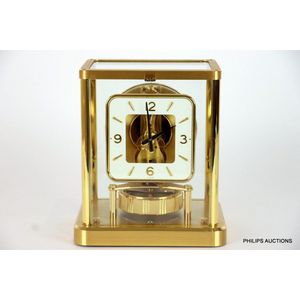Jaeger-Lecoultre Atmos Clock with Gold Frame and Visible Escapement
You must be a subscriber, and be logged in to view price and dealer details.
Subscribe Now to view actual auction price for this item
When you subscribe, you have the option of setting the currency in which to display prices to $Au, $US, $NZ or Stg.
- Movement - The technical name for the workings of a clock or watch, and does not include the dial or case.
- Pendulum - The pendulum was discovered around 1602 by Galileo Galilei, and was adopted for time keeping by the Dutch mathematician and natural philosopher, Christiaan Huygens, who excelled in astronomy, physics, and horology.
The pendulum comprises a metal rod usually of brass or steel with a metal disk, known as a bob, at the end. The movement of the pendulum is driven by weights or a spring, and as a pendulum swings in a regular arc, it was found accuracy could be controlled to within a few seconds a week.
Timekeeping can be adjusted by changing the height of the bob on the rod, making the pendulum either swing slower or faster.
The disadvantage of the pendulum was that changes in temperature also changed the length of the pendulum, interfering with the accuracy of the clock, and so in the 18th century two types of mercurial pendulums were invented which countered the movement in the steel rod.
The pendulum was the world's most accurate timekeeping technology until the invention of the quartz clock, regulated by a quartz crystal, in 1927. - Chapter Ring - A separate metal plate on the face of a clock, on which the numerals for the hours and sometimes parts of the hours, are displayed, usually wheel shaped and sitting on top of the dial plate. The chapter ring is often a feature of the clock and can be silvered or enamelled to stand as a contrast to its background. The hours are usually shown in Roman numerals, although in the late 19th and earlt 20th century, Arabic numerals became fashionable.
This item has been included into following indexes:
-
clocks, type
- Atmos 71
- four panel, four glass 33
Visually similar items

Cartier, ring, 18ct white gold mount containing a central emerald cut rectangular aquamarine, each shoulder channel set with nine square cut invisibly set sapphires and five tapered baguette cut diamonds, signed 'Cartier', numbered '45'. Weight 16 grams

A late 19th century French gilt brass carriage clock, c.1890, in a Corniche style case with white enamel dial and Roman numerals. Silvered platform with bi-metallic balance and lever escapement. Height 145 mm. Makers mark AM (running).

An Atmos Jaeger LeCoultre clock and original Atmos box.

A contemporary English brass carriage clock by Kenley, platform escapement. Height 17 cm. Width 9 cm. Depth 6.5 cm
